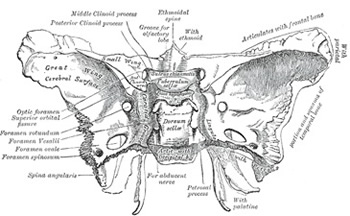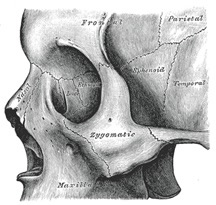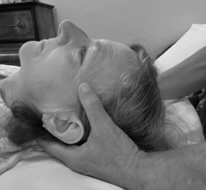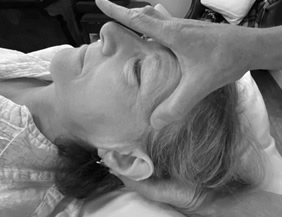Positive Health Online
Your Country

The Butterfly Bone
by Jonathan Lawrence(more info)
listed in craniosacral therapy, originally published in issue 274 - November 2021
I love all the cranial bones. Aesthetically, morphologically and functionally they are all expressions of the perfection of Nature.
Of all the cranial bones perhaps the most interesting in this respect is the sphenoid.[Fig1]

Fig 1. Superior Aspect of Sphenoid (Wikipedia, Gray’s Anatomy)
The bone spans the cranium and is palpable posterior to the frontal process of the zygoma.[Fig 2]

Fig 2 Sphenoid on surface of the cranium (Wikipedia, Gray’s Anatomy)
It forms a brace between the left and right side of the cranium. The sphenoid occupies a central position in the cranium both anatomically and functionally. It has huge functional significance. It forms a large part of the orbit and is in close association of the optic nerve. It attaches the tentorum cerebellum, it houses the pituitary gland, it projects inferiorly forming the pterygoid plates attaching muscles of mastication, articulates with the vomer connecting it to the palate.
Posteriorly it forms the spheno-basilar synchondrosis (SBS) with the occipital bone. This tightly bound joint is seen as the driver of the craniosacral system. The involuntary motion (IVM) within this system is named after the flexion/extension movement of the SBS. It should be noted at this point by most authorities that the tightly bound joint is deemed not to be able to accommodate motion. Nevertheless, motion is palpable. Judgements such as these stem from anatomical observations from dissection. Dead tissue is very different to living tissue. These issues are discussed by Chaitow.[1]
Flexion/Extension Explained
The rhythmic motions that underlie the motion of the cranial bones is not fully understood. There have been a number of rhythms identified but I will be working with the rhythm of ~10 flexion/extension cycles per minute. This was postulated by early theorists of the method and explained in Upledger’s book.[2] I will be referring to this subsequently as the CRI (cranial rhythmic impulse).
Flexion
The filling/expansion phase is known as flexion which describes the motion of the cranial base between the sphenoid and occiput at the spheno-basilar synchondrosis. This also leads to external rotation of lateral structures. The body broadens. During this phase the sacral apex moves anteriorly and the sacral base posteriorly.
Extension
The emptying/contraction phase known as extension with internal rotation of lateral structures. The body narrows. The sacral apex moves posteriorly and the sacral base anteriorly. Between the two phases is a neutral zone of relaxation.

Hold for adjustment of SBS (spheno-basilar synchondrosis)

Fig 4 Vault Hold. Allows for correction of sphenoid.
Patient lies supine on couch; practitioner sits at head of couch. One of the practitioner’s hands is placed under the patient’s occiput and the other is placed over the patient’s frontal bone with practitioner’s thumb and little fingers placed on the sphenoid posterior to the orbits and superior to the zygomas.
Sphenoid disturbance can occur as the result of a primary disturbance, such as direct trauma, during birth or as the result of a head injury. These often manifest to the practitioner as an intraosseous strain in the tissues of the bone. There is a particular feel to this, once recognized always remembered.
There are numerous secondary issues. The adjacent SBS being the most immediate.
The SBS can be disturbed in many ways. It can be restricted in flexion and extension, side-flexion/extension, rotation, compression, torsion, lateral shearing and superior/inferior sheers or even a combination of the above.
Clinically this can manifest with a number of symptoms from headaches to sinusitis to allergies, to hormones (the pituitary gland is housed on the upper surface) and mental conditions and even scoliosis (with torsion).[3]
Other secondary issues may be associated with Temporomandibular joint issues, occlusal issues (bite), disturbances in the meninges especially via the Reciprocal Tension Membrane (RTM) that divides the cranium into 4 compartments, left, right and cerebral/cerebellar. The RTM can be disturbed by trauma such as whiplash and meningeal disease.[4]
As a practitioner one needs to realise that disturbance of these structures have logical associations with the conditions and other listed above but not necessarily a direct relationship. This reflects the fact that the organism is a network and there are multiple factors in play. Clinical anecdotes can be useful but not necessarily a specific guide.
Case Studies
Jane (name changed) a 26-year-old woman came to see me to determine if there were any issues in her structure that prevented her conceiving. She and her partner had been trying for two years. She had suffered with dysmenorrhea since starting her periods until she took the contraceptive pill. Since giving up 2 years previously periods had been irregular. She wasn’t very active, had a sedentary job and had suffered few accidents, although she had been struck by a tennis ball on her nose as a teenager. She was her mother’s first child and experienced a long labour in which she was stuck for a good hour before being born naturally.
Her health had been good but had had upper teeth removed due to overcrowding and subsequently a brace to straighten her teeth.
On examination she had weak motion in the cranial system, a low rate and a low amplitude (degree of motion). A sense of compression was found anteriorly through the frontal bones and maxilla. Palpation of the nose revealed compression and distortion through the nasal septum possibly relating to birth and/or the tennis ball accident. Though the feel of the compression was old.
As the vomer [the small, thin bone separating the left and right nasal cavities in humans and most vertebrate] comprises a portion of the nasal septum, this was contacted intra-orally via the hard palate. The vomer was highly restricted, especially in flexion where it also rotated to the right. Correction was made doing an indirect technique in which the abnormal motion was encouraged in the direction of least resistance. As is often the case the vomer mobilized readily. On subsequently palpating the SBS the CRI was normal. It was clear that the vomer was severely restricting the system.
Jane also experienced a better feeling of vitality, her periods improved, and she became pregnant three months later. Does releasing the sphenoid do all this? Maybe, but it would be surprising if the effect that treatment had on the whole body-economy had not significantly contributed.
Alex (name changed) a 21-year-old student came complaining of headaches and insomnia. The insomnia was characterized by inability to go to sleep and having a busy mind.
He had been stressed living away from home and he ground his teeth during sleep. He was an active sportsman. Apart from a few insignificant sporting injuries he had not experienced any trauma in his life that he recalled. He was in good health but was prone to sinusitis which gave symptoms in the cheekbones and forehead.
On examination his frontal bone was restricted in flexion as was the sphenoid. The frontal bone felt compressed and that compression appeared to be at depth likely affecting the frontal cortex of the cerebrum. The sphenoid was flexed too as was the rest of the system.
Three treatments of the frontal bone and sphenoid resulted in less stress and improved sleep.
It seemed that the sphenoid was having a direct effect in the frontal cortex with associated neural function and the frontal bone. Releasing these structures allowed the system to function normally.
Alice (name changed) was 6 years old and presented with back soreness. This had come on for no apparent reason and was aggravated by running. She was a keen footballer and was understandably frustrated.
She had had a difficult birth and was delivered by forceps. There were no other obviously relevant factors.
On examination she was found to have a mild scoliosis and a slightly functionally shortened leg on the right side.
Cranially there was some mild asymmetry to the cranium. On palpation there as an intraosseous compression in the right sphenoid and a torsion of the SBS.
With correction of the torsion and compression in the first treatment the scoliosis lessened and the symptoms subsided in the following few days. The leg length returned to normal. Four treatments were required to achieve balance and she is seen 6 monthly for maintenance.
The case studies touch on only a few of the connections the sphenoid has. This beautiful Butterfly bone commands a central position in the cranial system and thus in the economy of the whole body. It orchestrates much of the structure and by default, function of the body. Allowing it to express its function freely had profound effects on the body’s ability to express health.[5]
In my opinion checking the craniosacral system routinely and correcting issues such as these could be an important way of preventing those irritation and debilitating chronic issues that beset so many of us.
References
- Chaitow, L. Cranial Manipulation: Theory and Practice. Edinburgh: Churchill Livingstone. 2005.
- Liem, T. Cranial Osteopathy: Principles And Practice. 2nd ed. Edinburgh: Churchill Livingstone. 2004.
- Upledger, J., Craniosacral Therapy. Berkeley, Calif.: North Atlantic Books. 2001.
- Magoun, H. Osteopathy In The Cranial Field. [Kirksville, Mo.]: [Journal Printing Co.].1966.
- Liem, T. Cranial Osteopathy. Seattle, WA: Eastland Press. 2009.
Comments:
-
No Article Comments available